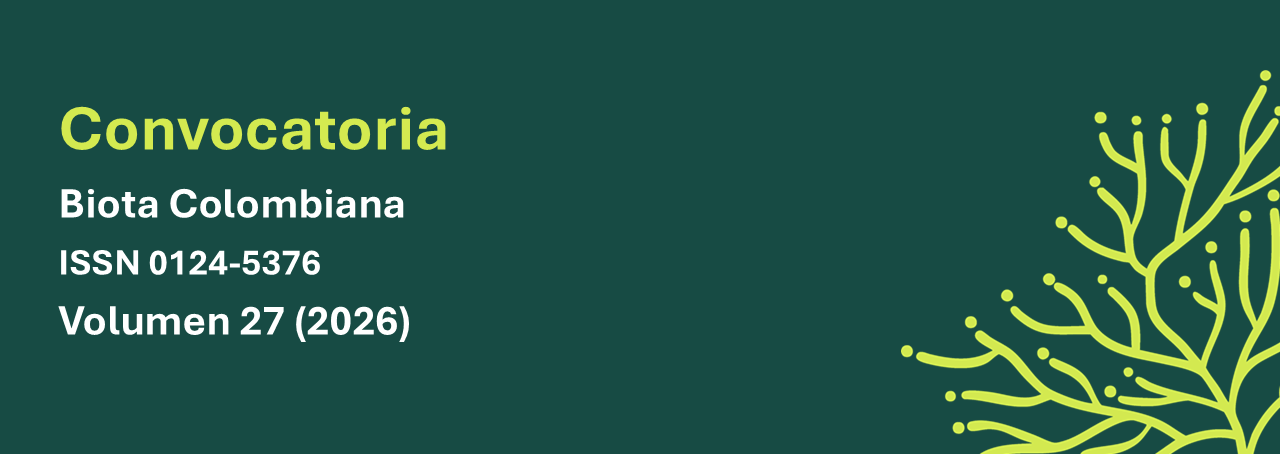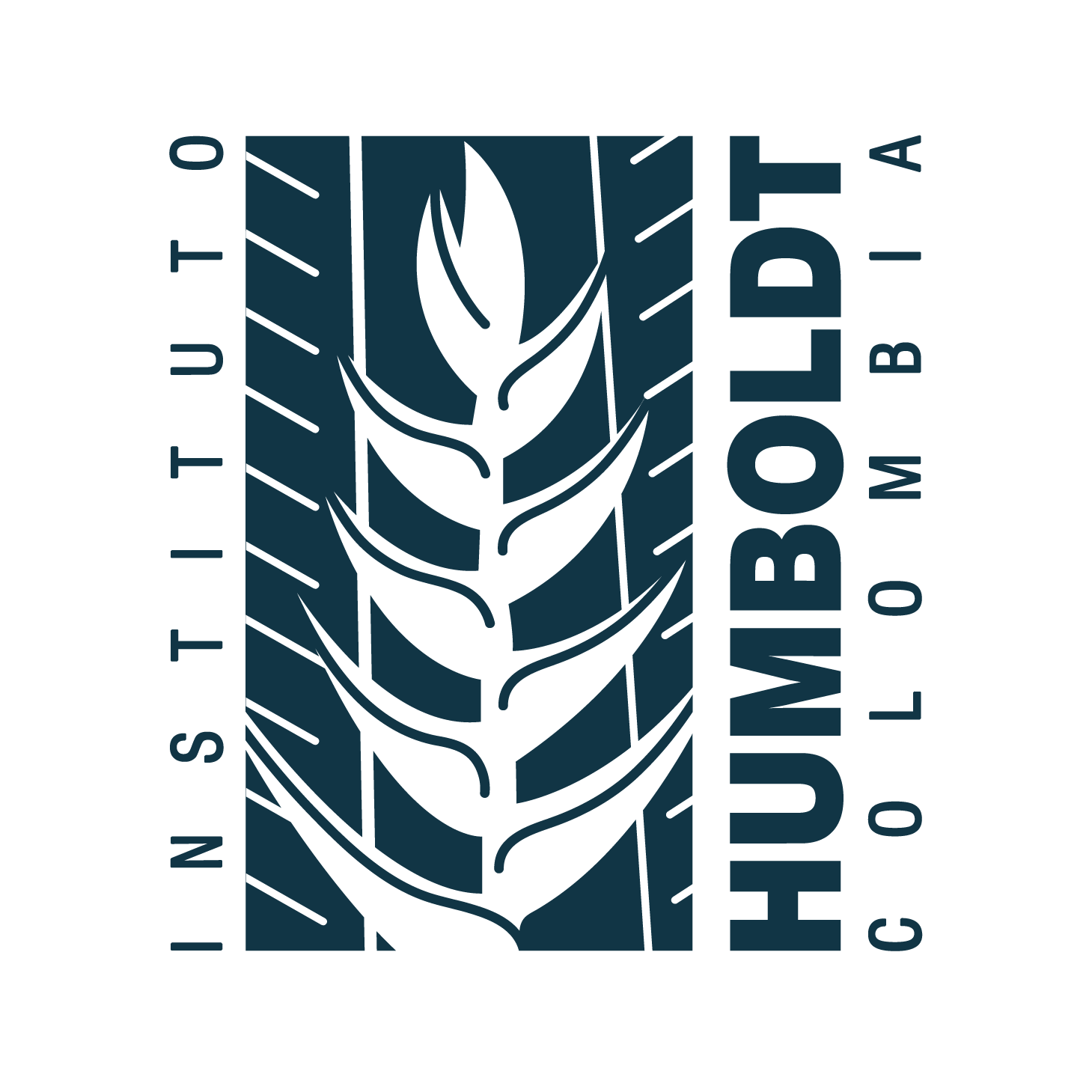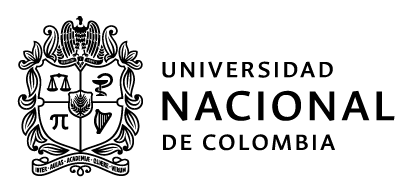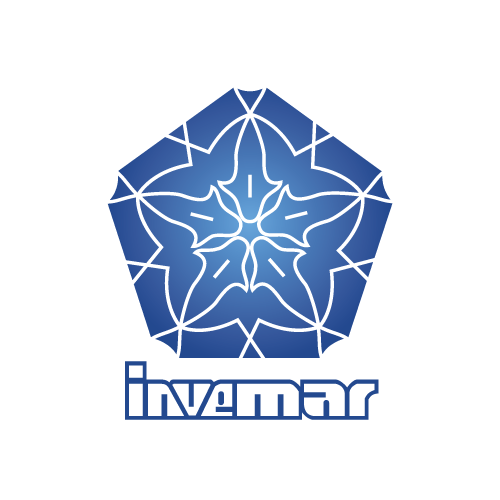Abstract (en):
Abstract (es):
En muestras recolectadas mensualmente, entre agosto de 2011 y agosto de 2012, en el embalse Riogrande II
(cuenca del río Grande, Antioquia, Colombia), se identificaron en total 29 géneros, 48 especies y una variedad
taxonómica, pertenecientes a Charophyta, Chlorophyta y Cryptophyta. De las 48 especies, 18 especies y una
variedad, son nuevos reportes para la ficoflórula colombiana. La división con mayor número de géneros fue
Chlorophyta, sin embargo, Staurastrum (Charophyta) fue el género más diverso y de mayor contribución a la
biomasa. Las diferencias entre las características descritas en la literatura y las observadas en los ejemplares,
dificultaron la determinación taxonómica, lo cual plantea la necesidad de realizar estudios morfológicos
detallados.
Keywords:
Grande River Drainage, Phycoflora, Phytoplankton, Taxonomy, Tropical reservoir (en)
References
Aguirre, N., J. Palacio y J. Ramírez. 2007. Características limnológicas del embalse El Peñol-Guatapé, Colombia. Revista de Ingenierías Universidad de Medellín 6 (10): 53-66.
Brook, A. J. 1958. Desmids from the plankton of some Irish loughs. Proceeding of the Royal Irish Academy 59B (6): 71-91.
Bustamante-Gil, C., J. J. Ramírez-Restrepo, A. Boltovskoy y A. Vallejo. 2012. Spatial and temporal change characterization of Ceratium furcoides in the equatorial reservoir Riogrande II, Colombia. Acta Limnologica Brasiliensia 24 (2): 207-219.
Canosa, A. y G. Pinilla. 2007. Relaciones entre las abundancias del bacterioplancton y del fitoplancton en tres ecosistemas lénticos de los Andes Colombianos. Revista de Biología Tropical 55 (1): 135-146.
Castro, A. A. J. y C. E. M. Bicudo. 2007. Flora ficológica do Estado de São Paulo. Cryptophyceae. Rima, FAPESP. São Paulo. 121 pp.
Comas, A. 1996. Las Chlorococcales duliacuícolas de Cuba. Bibliotheca Phycologia Band 99. Cramer, Stuttgart. 192 pp.
Daufresne, M., K. Lengfellner y U. Sommer. 2009. Global warming benefits the small in aquatic ecosystems. Proceding of the National Academy of Sciences 106: 12788-12793.
Duque, S. y J. Ch. Donato. 1988. Estudio del fitoplancton durante las primeras etapas de llenado del embalse de la Central Hidroeléctrica de Betania, Huila, Colombia. Revista Facultad de Ciencias, Universidad Javeriana 1 (2): 29-52. Disponible en: http://revistas.javeriana.edu.co/index.php/scientarium/article/view/5090/3930
Ettl, H. 1983. Chlorophyta I. Phyomonadina. Pp. 14–807. En: Ettl, H., J. Gerloff, H. Heynig, D. Mollenhauer (Eds.) SüBwasserflora von Mitteleuropa. Gustav Fischer Verlag. Stuttgart. New York.
Fernandes S, C. E. M. Bicudo. 2009. Criptógamos do Parque Estadual das Fontes do Ipiranga, São Paulo, SP. Algas, 26: Chlorophyceae (famílias Chlorococcaceae e Coccomyxaceae). Hoehnea 36 (1): 173-191.
Fott, B. 1969. Studies in Phycology. E. Schweizerbart’sche Verlagsbuchhandlung, Stuttgart. 304 pp.
Gaviria, S. 1991. Monitoreo de embalses del sistema de acueducto de Bogotá. Revista Acodal 147: 29-47.
Godinho, L. R., A. A. Comas y C. E. M. Bicudo. 2010. Criptógamos do Parque Estadual das Fontes do Ipiranga, São Paulo, SP. Algas, 30: Chlorophyceae (família Scenedesmaceae). Hoehnea 37 (3): 513-553.
Hegewald, E. y P. C. Silva. 1988. Annotated catalogue of Scenedesmus and nomenclaturally related genera, including original descriptions and figures. Bibliotheca Phycologica Band 80. Cramer, Stuttgart. 587 pp.
Heynig, H. y L. Krienitz. 1982. Monoraphidium negledum n. sp. sowie einige Bemerkungen zu den Gattungen Monoraphidium, Chlorolobion und Keratococcus (Chlorococcales). Archiv für Protistenkunde 125 (1): 335-344.
Hindák, F. 1977. Studies on the chlorococcal algae (Chlorophycea). I. Biologické Práce. Bratislava. 190 pp.
Hindák, F. 1984. Studies on the chlorococcal algae (Chlorophycea). III. Biologické Práce. Bratislava. 308 pp.
Hindák, F. 1988. Studies on the chlorococcal algae (Chlorophycea). V. Biologické Práce. Bratislava. 225 pp.
Komárek, J. y B. Fott. 1983. Das Phytoplankton des SüBwassers. E. Schweizerbart’sche Verlagsbuchhandlung. Stuttgart. 1044 pp.
Komárková-Legnerová, J. 1969. The systematics and ontogenesis of the genera Ankistrodesmus Corda and Monoraphidium gen. nov. Pp. 75-144. En: Fott, B. (Ed.) Studies in Phycology. Stuttgart: Schweizerbart’sche.
Krienitz, L., C. Bock, H. Nozaki y M. Wolf. 2011. SSUrRNA gene phylogeny of morphospecies affiliated to the bioassay alga “Selenastrum capricornutum” recovered the polyphyletic origin of crescent-shaped Chlorophyta. Journal of Phycology 47: 880–893.
León-López, N., C. A. Rivera-Rondón, A. Zapata, J. Jiménez, W. Villamil, G. Arenas, C. Rincón y T. Sánchez. 2012. Factors controlling phytoplankton in tropical high-mountain drinking-water reservoirs. Limnetica 31 (2): 305-322.
Loaiza-Restano, A. M. 2013. Família Hydrodictyaceae (Sphaeropleales, Chlorophyceae) no Estado de São Paulo: levantamento florístico. Dissertação de Mestrado. Instituto de Botânica da Secretaria de Estado do Meio Ambiente. São Paulo. 164 pp.
Loaiza-Restano, A. M., J. J. Ramírez, R. O. Echenique, A. Vallejo y L. Y. Ortiz. 2011. Dinámica espacio-temporal de cuatro especies de Staurastrum (Meyen 1829, emend. Ralfs 1848) en un embalse eutrófico colombiano. Oecologia Australis 15 (3): 726-746.
Mazo-B., D., J. J. Ramírez, A. Díaz-C. 2015. Caracterización física y química del embalse Riogrande II (Antioquia), Colombia. Actualidades Biológicas 37 (103): 155-168.
Meneses, V., A. Vergara, J. J. Ramírez, H. Palacio. 2011. Estudio autoecológico de Schroederia setigera en un embalse ecuatorial. Boletín de la Sociedad Argentina de Botánica 46 (2): 96.
Naundorf, G. 1990. Caracterización de la comunidad fitoplanctónica y determinación de la productividad primaria del embalse “La Salvajina” y su área de influencia. Revista Asociación Colombiana de Ciencias Biológicas 4: 154-163.
Prescott, G. W., H. T. Croasdale y W. C. Vinyard. 1972. North American Flora. The New York Botanical Garden. 84 pp.
Prescott, G. W., H. T. Croasdale y W. C. Vinyard. 1975. A Synopsis of North American Desmids. Part II. Desmidiaceae: Placodermae. Section 1. University of Nebraska Press.USA. 275 pp.
Prescott, G. W., H. T. Croasdale, W. C. Vinyard y C. E. M. Bicudo. 1982. A Synopsis of North American Desmids. Part II. Desmidiaceae: Placodermae. Section 4. University of Nebraska Press.USA. 700 pp.
Ramírez, J. J. 1986. Fitoplancton de red en el embalse de El Peñol. Actualidades Biológicas 15 (56): 2-13.
Ramírez, J. J., C. E. M, Bicudo, G. Roldán y L. C. García. 2000. Temporal and vertical variations in phytoplankton
community structure and its relation to some morphometric parameters of four Colombian reservoirs. Caldasia 22 (1): 108-126.
Ramírez, J. J., R. González-Ballesteros y F. L. Gutiérrez. 2012. Establecimiento del nutriente limitante con base en los cambios de la estructura del ensamblaje fitoplanctónico en un embalse tropical colombiano. Caldasia 34 (2): 421-441.
Ramírez, M. y G. Guillot. 2001. Variaciones espaciales y temporales de la abundancia y diversidad del fitoplancton del embalse tropical de Betania, Huila-Colombia: 237-251. En: Alveal y Antezana (Eds). Sustentabilidad de la biodiversidad, un problema actual. Bases Científico-Técnicas. Teorizaciones y Proyecciones. Universidad de Concepción, Chile.
Ramírez, J. J., F. Gutierrez y A. Vargas. 2005. Respuesta de la comunidad fitoplanctónica a experimentos de eutrofización artificial realizados en la represa La Fe, El Retiro, Antioquia, Colombia. Caldasia 27 (1):103-115.
Ramírez, J. J. y T. Machado. 1982. Influencia de la precipitación y los ortofosfatos en el fitoplancton de la represa La Fe. Actualidades Biológicas 11 (39): 3-21.
Ramos, G. J. P, C. E. M. Bicudo y C. W. do N. Moura. 2015. Scenedesmaceae (Chlorophyta, Chlorophyceae) de duas áreas do Pantanal dos Marimbus (Baiano e Remanso), Chapada Diamantina, Estado da Bahia, Brasil. Hoehnea 42 (3): 549-566.
Roldán, G., A. Bohórquez, R. Cataño y J. Ardila. 2000. Estudio limnológico del embalse del Guavio (Colombia). Revista de la Academia Colombiana de Ciencias 24 (90): 73-84.
Sant’Anna, C. L. 1984. Chlorococcales (Chlorophyceae) do Estado de Sao Paulo, Brasil. Bibliotheca Phycologica Band 67. Cramer, Vaduz. 348 pp.
Stoyneva, M. P., C. Cocquit, G. Gärtner y W. Vyverman. 2007. Oocystis lacustris Chod. (Chlorophyta, Trebouxiophyceae) in Lake Tanganyika (Africa). Linzer Biologische Beiträge 39 (1): 571-632.
Teiling, E. 1967. The desmid genus Staurodesmus. A taxonomic study. Arkiv För Botanik, Serie 2, Band 6, nr 11. Almqvist y Wiksell. Stockholm. 629 pp.
Uherkovich, G. 1966. Die Scenedesmus-Arten Ungarns. Akadémia Kiadó, Budapest. 173 pp.
Uribe, A. y G. Roldán. 1975. Estudio comparativo de algunas características físicoquimicas y biológicas del embalse El Peñol. Actualidades Biológicas 4: 2-12.
West, W., G. S. West y N. Carter. 1923. A Monograph of the British Desmidiaceae. Vol. 5. The Ray Society. London. 299 pp.
How to Cite
The works published in the journals of the Alexander von Humboldt Biological Resources Research Institute are subject to the following terms, in relation to copyright:
1. The patrimonial rights of the published works are assigned to Instituto de Investigación de Recursos Biológicos Alexander von Humboldt. The authors or institutions that elaborate the document agree to transfer the patrimonial rights to the Humboldt Institute with the sending of their articles, which allows, among other things, the reproduction, public communication, dissemination and dissemination of works.
2. The works of digital editions are published under a Creative Commons Colombia license:
Creative Commons License
This work is licensed under a Creative Commons Atribución-NoComercial-SinDerivar 4.0 Internacional.
> Attribution - Non-commercial - No Derivative: This license is the most restrictive of the six main licenses, it only allows others to download the works and share them with others, as long as their authorship is acknowledged, but they cannot be changed in any way, nor can they be used commercially.
3. The authors, when submitting articles to the editorial process of the magazines published by the Humboldt Institute, accept the institutional dispositions on copyright and open access.
4. All items received will be subjected to anti-plagiarism software. The submission of an article to the magazines of the Humboldt Institute is understood as the acceptance of the review to detect possible plagiarism.
5. The works submitted to the editing process of the magazines of the Humboldt Institute must be unpublished.


















